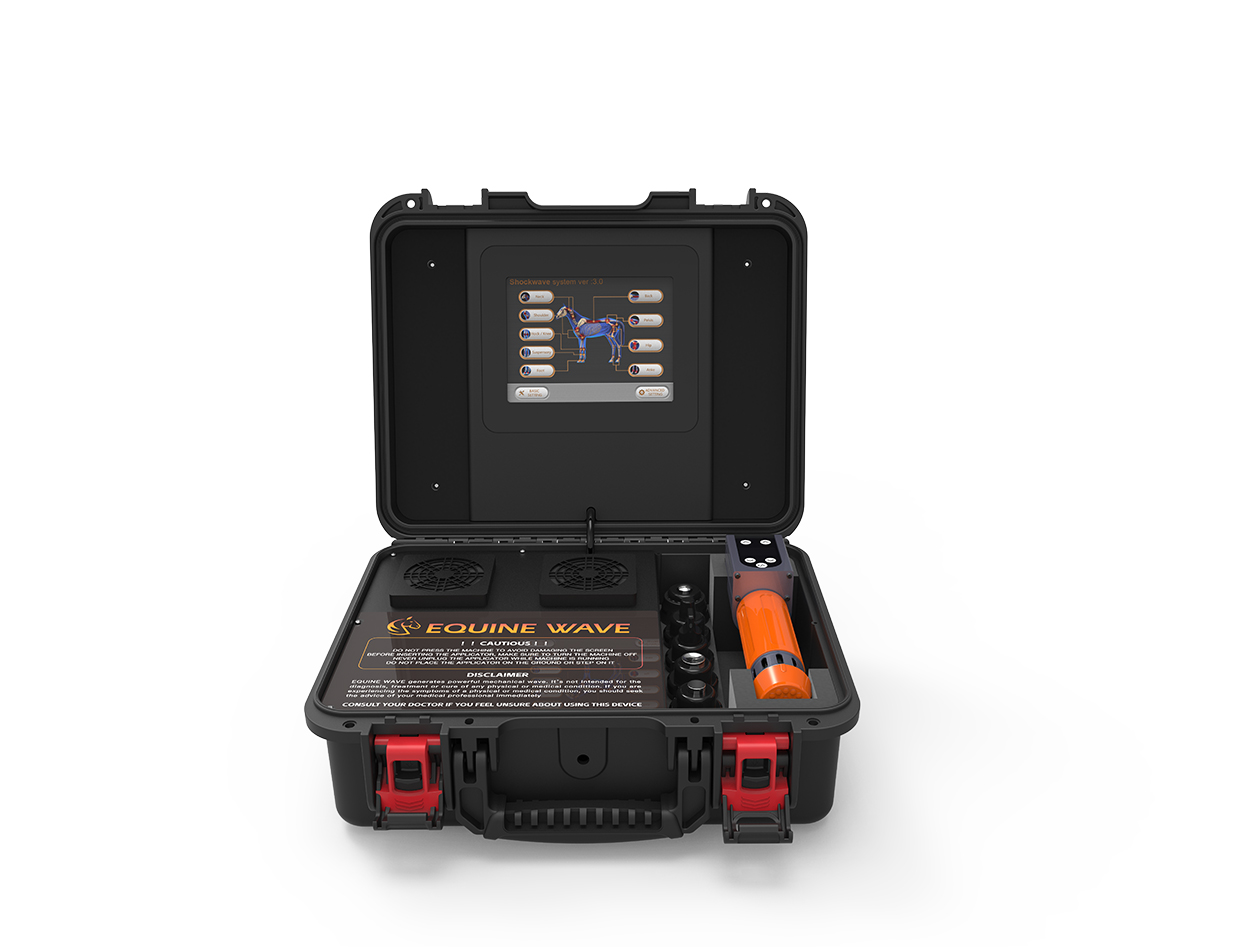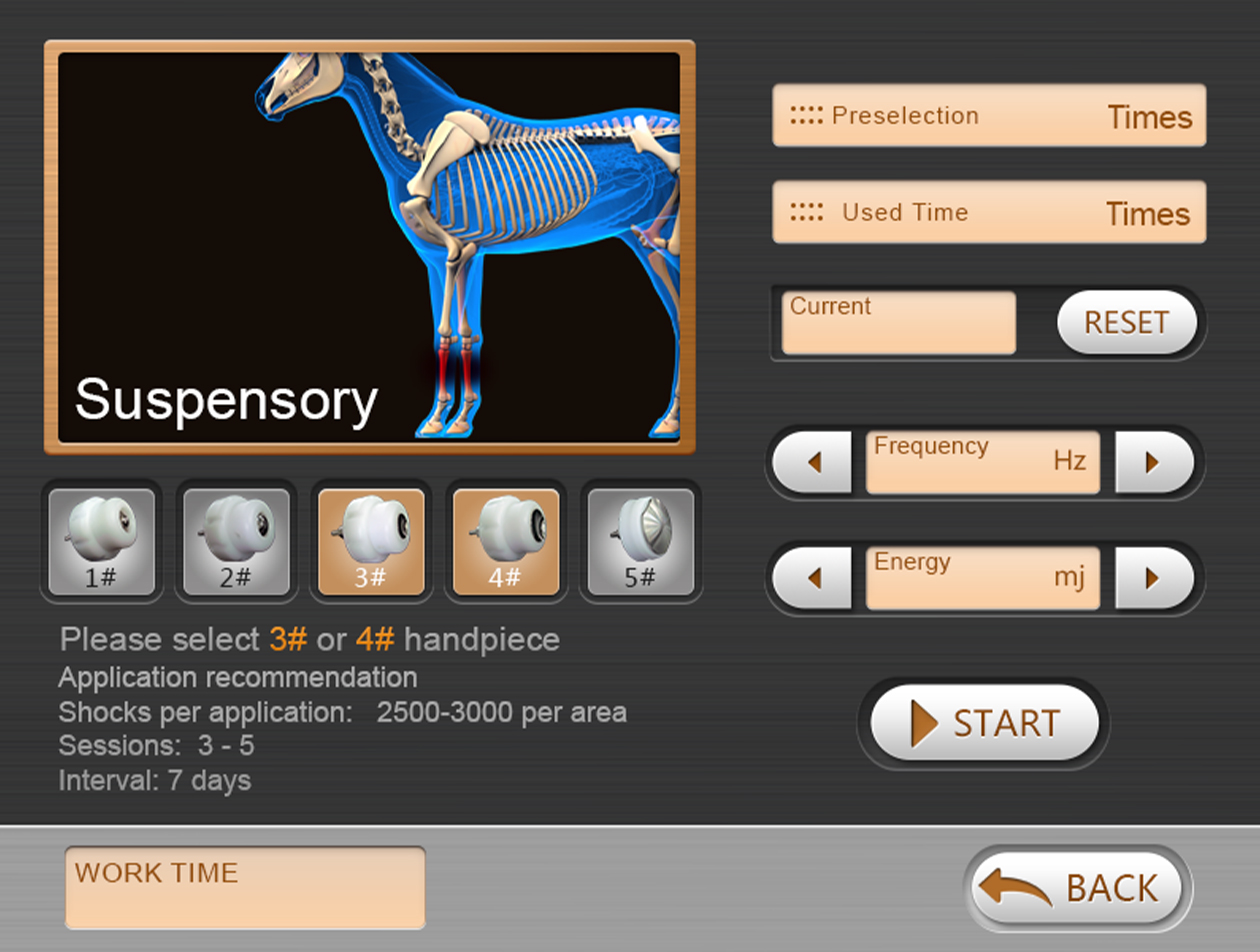



Horses, as athletic animals (e.g., racehorses, show jumping, equestrian sports), frequently endure immense pressure on their tendons, ligaments, and joints, making conditions like tendinitis, ligament injuries, and osteoarthritis common. Shockwave therapy is a non-invasive, drug-free, side-effect-free, and long-term treatment that can help horses recover quickly and maintain long-term health.
Shockwave therapy uses high-frequency sound waves to penetrate deep tissues, utilizing cavitation effects and controlled micro-trauma to stimulate cell repair and angiogenesis, while inhibiting pain signal transmission. This results in non-invasive, highly effective tissue repair and chronic pain relief.
Focused Shockwave (Focused ESWT) vs. Radial Shockwave (Radial ESWT)
| Comparison Factor | Focused Shockwave (Focused ESWT) | Radial Shockwave (Radial ESWT) |
| Energy Penetration Depth | Deep tissues (10-12 cm), reaching bones, joint capsules, and deep ligaments. | Shallow tissues (2-4 cm), targeting muscles, fascia, and superficial tendons. |
| Energy Distribution | High-energy focus, concentrated energy, precise targeting (similar to a laser). | Diffused energy, wide coverage area (similar to a shock gun). |
| Treatment Mechanism | Promotes deep bone and cartilage repair through cavitation effects and stress stimulation. | Improves shallow blood circulation and relieves muscle stiffness and inflammation through mechanical vibrations. |
| Indications | Osteoarthritis, stress fractures, sesamoiditis, deep ligament injuries. | Muscle strains, fascia inflammation, superficial tendonitis, chronic hoof ulcers. |
| Device & Operation | Requires professional guidance (e.g., ultrasound), complex equipment, higher cost. | Handheld, easy operation, no precise positioning required, suitable for quick treatment. |
| Pain Level | May be intense (local anesthesia or sedation may be required). | Less painful, most horses can tolerate it. |
Summary:
Focused shockwaves are ideal for precision treatment of deep bone and ligament issues, while radial shockwaves are more suitable for superficial soft tissue inflammation and muscle rehabilitation. If you're new to shockwave therapy, we recommend starting with the more affordable, easy-to-use radial shockwave devices.
Shockwave therapy can effectively treat the following conditions in horses:
Tendon and Ligament Injuries: e.g., suspensory ligament desmitis, flexor tendonitis (especially chronic fibrotic changes), partial ligament tears
Bone and Joint Issues: osteoarthritis, sesamoiditis, bone spurs, stress fractures, delayed bone remodeling
Soft Tissue Inflammation: back muscle fascia inflammation, chronic hoof ulcers, poorly healed wounds
Pain Management: unexplained lameness, post-surgical adhesion pain, muscle fatigue
Acute infection areas, open bone fractures, clotting disorders, tumor sites, pregnant mares
HIGHTLIGHTS
◉ Only 7.8KG, it means compact size: easy to carry and mobility.
◉ High Reliability: rugged case.
◉ User friendly: Intelligent operation guidance.
◉ Professional intelligent guidance: 10 different treatment areas with indications and preset parameters.
◉ Compact case with all accessories in, easy to carry
◉ 8-inch user-friendly touchscreen
◉ Suitable for home use, veterinary clinics, equine rehabilitation centers and equine professionals

HORSE INTERFACE
◉ Offers 10 body parts to choose
◉ Recommend tips
◉ 6 different preload
◉ 8-inch user-friendly touchscreen
◉ 2 Modes: C mode & P mode(C:Comfortable Mode; P: Professional Mode)

When treating horses, ensure the correct therapy areas (muscles, ligaments, joints, soft tissues). Accurately targeting these areas will enhance treatment effectiveness and minimize side effects.
Due to the differences in horse anatomy, special shockwave devices designed for horses are necessary. Compared to human devices, equine devices may require stronger energy output and larger treatment coverage. Radial shockwave is suitable for superficial soft tissue injuries, while focused shockwave is more effective for deep tissue issues.
Shockwave therapy intensity should be adjusted based on the horse's individual condition (e.g., age, size, injury severity). High energy can cause discomfort or injury, while low energy might reduce effectiveness. Start with a lower intensity and gradually increase based on the horse’s response.
Each treatment session should last between 10 and 20 minutes, depending on the horse's tolerance. Avoid prolonged treatment to prevent discomfort.
After treatment, horses may experience mild discomfort or muscle tension, which is normal. However, if significant pain or discomfort occurs, cease treatment immediately and consult with a veterinarian.
Do not conduct treatments too frequently. It is recommended to allow a 3-5 day gap between sessions to prevent overstimulation of the damaged tissue.
Always seek guidance from an experienced veterinarian or physiotherapist when using shockwave devices. Improper use can lead to ineffective treatment or side effects.
Avoid shockwave therapy in horses with malignancies, infected areas, or open wounds.
Pregnant mares should avoid shockwave therapy to prevent harm to the fetus.
Horses with severe heart or blood conditions should not undergo shockwave treatment.
Shockwave therapy is generally non-invasive. Most horses will experience mild vibrations or pressure during treatment but should not feel severe pain. Treatment intensity varies based on individual tolerance, and some horses may feel slight discomfort. To minimize discomfort, we recommend starting with low energy and gradually increasing based on the horse’s response. If a horse shows significant distress, stop treatment and seek veterinary advice.
Results vary depending on the horse’s condition and individual response. Most horses experience significant improvement within 3-6 weeks of therapy. Mild soft tissue injuries may show improvement after 1-2 treatments. More severe conditions may require longer treatment periods. Consistent therapy and proper rehabilitation will help accelerate recovery.
To purchase our recommended shockwave therapy devices for horses, you can:
Click here to view our best shockwave therapy devices for horses.
Contact Us via email, social media, or WhatsApp for professional advice and support.
Call us at (+8613060901678, Amber Han) for detailed product information and purchase assistance.
We offer competitive prices and reliable, high-quality devices.
Shockwave therapy is suitable for most horses, regardless of breed or age. However, the horse’s size, age, and overall health may affect treatment effectiveness. Older horses or those with severe health issues may require adjusted intensity levels. For horses recovering from severe injuries, it’s important to consult with a veterinarian before starting therapy.
Shockwave therapy offers a highly effective and safe treatment for horses, alleviating pain, accelerating recovery, and improving overall health. We recommend that horse owners choose the appropriate shockwave therapy device based on the horse’s specific needs and consult a veterinarian for guidance. Early intervention and proper health management will significantly improve the horse's health and athletic performance.